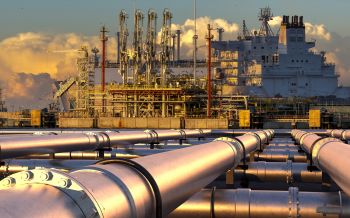Amir Sharifi is a senior managing director at French private investment house Ardian. In 2021, he co-founded Hy24, the world’s first investment management company fully dedicated to scaling up the clean hydrogen economy. In this exclusive interview, he explains why clean hydrogen is going to fit into the shoes of the current oil and gas industry, and highlights that clean hydrogen, while set to play a relatively small role in the future energy mix, but often described as an “over-hyped” concept, faces the same unwarranted scepticism renewables faced 15 years ago.
An ‘immense solution’
Sharifi has been part of Ardian for 17 years. At Hy24, he serves as the company’s chief investment officer. As an idea, Hy24 sprang notably from Sharifi’s experience heading Ardian’s energy transition business and took shape during the repeated Covid-19 lockdowns of 2020-21.
“I had been investing in renewable energies globally, starting with France, before developing the Nordics,” Sharifi says. “But when asked what I thought was the future of Ardian’s energy transition investments, I realised that, actually, investing more in renewable energy for the sole purpose of producing power is going to face limitations. I became conscious of renewable power’s intermittency and lack of storability but also that we can’t reach net-zero targets without really tackling fossil fuel use in heavy industry.”
At the start of this decade, hydrogen was being seen as “an immense solution to many things,” Sharifi recalls. It led him to create a hydrogen working group at Ardian, “simply to understand the topic better. It started with a couple of people involved, over takeaway pizzas, and three years down the line we are managing a EUR 2 billion fund.”
The creation of Hy24 coincided with rapid developments in the hydrogen sphere, as key economies, such as France, Spain and Germany, were announcing hydrogen strategies at the time.
“It was a confirmation that it was the right moment to start looking at clean hydrogen seriously,” Sharifi says. “Then three major champions of hydrogen came on the scene – Air Liquide, Vinci and TotalEnergies – who joined forces and each committed EUR 100 million, provided it led to a EUR 1.5 billion infrastructure fund, which Hy24 took on in 2022. It felt like a perfect alignment of the planets at every step.”
Sharifi co-founded Hy24 with Pierre-Etienne Franc, co-founder and chairman of FiveT Hydrogen, an investment platform dedicated to low-carbon hydrogen, and Laurent Fayollas who is today Hy24’s President. Franc, who had more than two decades under his belt working for the industrial group Air Liquide, and is today considered a leading architect of the hydrogen economy, is Hy24’s CEO. The “marriage” between Ardian and FiveT Hydrogen in the form of Hy24 aimed to bring together the best brains and skills from the realms of private equity and hydrogen asset management.
“Franc left Air Liquide at the start of 2021 because he wanted to launch a hydrogen asset specialist, which became FiveT Hydrogen,” says Sharifi. The initiative was backed initially by French industrial leaders Air Liquide, TotalEnergies and Vinci, quickly joined by US industrial players active in the hydrogen field: Plug, Chart Industries and Baker Hughes.
The Ukraine war delayed green mandates, but the lag didn’t hamper clean hydrogen’s dynamic.
Sharifi adds: “Franc had started the gathering process of the three main industrial investors but was actively looking for a way to build the proper asset manager to develop such a new asset class type of funds. Franc has a solid understanding of clean hydrogen. It rapidly became clear that the best combination to develop a strong play was to ally with Ardian, which led to the creation of a 50/50 joint venture in hydrogen investment management, which we named Hy24.”
By December 2021, Hy24 had closed its first EUR 1 billion for a first-time fund dedicated to clean hydrogen infrastructure.
Push for green
After the closing of this first EUR 1 billion, demand for Hy24’s services picked up, driven by a “really strong push for green,” says Sharifi. In the early years of this decade, hydrogen was at the top of the agenda in a number of EU regulations – for example, ReFuelEU for aviation and FuelEU Maritime. Both followed the approval in January 2020 of the EU Green Deal, which aims to reduce the EU’s net greenhouse gas (GHG) emissions by at least 55%, compared to 1990 levels, by 2030.
“Things went very fast. We didn’t have the issue we now have with interest rates. And as there wasn’t any big global initiative on hydrogen, and we were the first and largest initiative for clean hydrogen investment management, we were able to get a lot of backing from big pension funds and insurance companies from all over the world. It quickly became a fundraising success story.”
Although private equity firms have, overall, been struggling with a massive increase in borrowing rates in the past 12 months – in great part triggered by repeated geopolitical and economic “earthquakes” – Hy24 has in relative terms been “rather lucky” because it is a young entity, says Sharifi.
“It’s much more difficult to be in a position where you’ve already put a lot of debt in your current company, as refinancing becomes a risk, more than an opportunity,” he explains. “Or you find yourself in a situation where you need to sell your company, and there’s no debt available for the buyer. It’s very different if you’re at a greenfield stage, like we are. Although the war in Ukraine led to a delay in the drafting and implementation of a number of critical mandates, such as the EU’s renewable energy directive, and despite increasing interest rates, this lag doesn’t hamper the dynamic.”
The current dynamism in clean hydrogen infrastructure is reflected in the Hydrogen Council’s estimation that out of the EUR 500 billion projects announced as of 2023, 10% of them are already at final investment decision (FID) stage and beyond, Sharifi points out.
“That 10% may not sound like a big percentage, but it still represents EUR 50 billion of projects being decided. Some of them are actually in construction already, the most famous being NEOM in Saudi Arabia. We also have one in our portfolio: H2 Green Steel in Sweden. Also, Air Liquide has a few smaller-scale plants that are being built in France and Canada.”
Making the switch
The clean hydrogen industry “is really moving – we are really seeing it,” stresses Sharifi. Crucially, the gap between grey and green hydrogen production has narrowed sufficiently in locations with access to cheap power, such as Spain and the Nordic countries, to encourage key consumers to make the switch to green, he highlights.
Clean hydrogen faces the same scepticism renewables faced 15 years ago.
“In places where you get your baseload from hydro, or from using a combination of wind and hydro, the low cost of power is driving a relatively decent cost of clean hydrogen, despite it not being at scale yet,” he says. “And thanks to regulations, the demand is growing among big CO2 emitters, for whom the switch is a no-brainer. We see that in our plants in Denmark and Spain, where we have projects with the likes of Repsol and Cepsa. The demand obligation is very helpful. And if you look at every EU mandate – from aviation to maritime to the phase out of the ETS [European Trading System] – Hy24 has one case for almost every driving mandate.”
Nevertheless, clean hydrogen remains an illiquid market, with no integrated green network anywhere in the world today. As a result, “it continues to be driven by bilateral discussions between the buyer and the seller of a clean hydrogen product,” Sharifi says. “And if you don’t have a buyer, it doesn’t make sense to build plants and produce the product. That is where the demand obligations kick in. In the case of aviation, ReFuelEU asks for e-fuels to represent 2% of total demand by 2025, which goes up to 40% in a decade. This represents billions of litres of fuel, which, in all honesty, is much more than what is actually going to be produced.”
At the same time, shipowners, airlines and airports “are ready to sign the offtake,” he says. “The price is not the limitation. The issue is more the availability of that truly sustainable fuel. Even if it’s three or four times more expensive than conventional jet fuel, that’s okay, because it gets blended into a product. Down the line, its impact on the price of the airline ticket is less than 5%, which pales in comparison to the 50% increase in airfares seen in recent years.”
Although sustainable aviation fuel (SAF) derived from biomass is well ahead from e-SAF at the moment in terms of traded volumes, the growth of e-fuels, or e-SAF, in aviation will be driven by regulatory demand obligations, but also biomass supply constraints, says Sharifi.
“Biomass is by definition very difficult to source if sourced from poultry or agriculture: it’s a complex logistical chain, and the volumes are not that big,” he explains. “It’s a challenge to get sufficient amounts of biomass, which is why I think e-fuels have a prosperous future ahead of them, because they solve this issue. Even if CO2 remains scarce, biomass feedstock has constraints not faced by e-fuels. But to hit the targets for e-fuels in aviation, so much needs to be done until we actually have sufficient production in place.”
Unlocking locations
Responding to the assertion that the hydrogen economy is an “over-hyped” concept, Sharifi points to the fact that renewables faced similar scepticism 15 years ago.
“Most players in the market saw it as a silly thing, that it was never going to be competitive,” he says. “In France they said it was never going to compete against nuclear. In other countries, that it was never going to be a solution against oil and gas. 15 years later, we can see that this view has been proven wrong. There was sufficient regulatory support at the beginning to kick off the industry, which led the cost curve to go down massively – much more than what anyone would have expected at that time.”
For clean hydrogen to occupy even a fraction of the future energy mix is a massive challenge.
Sharifi anticipates the same pattern with clean hydrogen and, although it is not a “one-size-fits-all” solution for the energy transition, fulfilling the ambition of clean hydrogen having a 10% to 20% share in the global energy mix by 2050 still represents “trillions of investments to get there,” he maintains.
“It’s going to take time, but the foundations are there. We have historical and binding commitment from EU states to net zero and to certain regulations with hydrogen at the core of their strategies. And if you look at countries like Japan and South Korea, they don’t have many green alternatives, as they lack space.”
When it comes to clean hydrogen shipping, Sharifi believes it is most likely to first develop in the form of ammonia, before liquefied hydrogen, which has its own complications in terms of boil off and cost of refrigeration. “Ammonia has the advantage of already being a commodity that is traded and travels around the world in million tonnes. The shipping industry around it already exists. But for this to work, it has to come from locations where you can really get the power source, from combined wind and solar or hydro, as close as possible to baseload, which has a big impact on the capex.”
In turn, shipping green ammonia to potential demand centres like Japan and South Korea is set to open up remote locations, for example in the Middle East, Australia, Canada, Chile and Namibia, that have always been “very attractive” for renewable production “but were locked-in, isolated places because there was a limited grid, or not enough local consumption nearby, to transport that renewable power,” Sharifi says.
The fact that hydrogen derivatives can travel long distances and be stored “is really replicating how LNG played out,” Sharifi believes, adding that, to some extent, hydrogen “is simply going to fit into the shoes of the current oil and gas industry.”
Versatile solution
Sharifi is keen to stress that no true supporter of, or investor in, clean hydrogen “will ever tell you it is the one and only solution” for the future of energy. However, for clean hydrogen to occupy “even a fraction” of the future energy mix “is a massive challenge,” he says.
“The biggest bulk of energy transition solutions will come from electrification,” Sharifi stresses. “But you need around 650 GW of wind and solar capacity to be installed every year until 2030 – four times the current pace – for mandates to be met. These are big figures. If you only count on renewable power, many targets will not be met. Renewable power is intermittent, while power itself can’t travel very long distances. Distance and time are the two big issues that power, and renewable power in particular, need to deal with.”
Ultimately, this drawback is why “molecules have been so successful in the past – why oil and gas have dominated energy in the last 50 years and represent 80% of the energy mix,” Sharifi says. “It’s simply because they are so versatile and easy to transport. Hydrogen can tackle the part that electrification cannot solve, especially with hard-to-abate sectors, while acting as a vector for renewable power from promising places that are today far from consumption centres.” - KT
Subscription Benefits
Our three titles – LNG Business Review, Gas Matters and Gas Matters Today – tackle the biggest questions on global developments and major industry trends through a mixture of news, profiles and analysis.
LNG Business Review
LNG Business Review seeks to discover new truths about today’s LNG industry. It strives to widen market players’ scope of reference by actively engaging with events, offering new perspectives while challenging existing ones, and never shying away from being a platform for debate.
Gas Matters
Gas Matters digs deep into the stories of today, keeping the challenges of tomorrow in its sights. Weekly features and interviews, informed by unrivalled in-house expertise, offer a fresh perspective on events as well as thoughtful, intelligent analysis that dares to challenge the status quo.
Gas Matters Today
Gas Matters Today cuts through the bluster of online news and views to offer trustworthy, informed perspectives on major events shaping the gas and LNG industries. This daily news service provides unparalleled insight by drawing on the collective knowledge of in-house reporters, specialist contributors and extensive archive to go beyond the headlines, making it essential reading for gas industry professionals.






